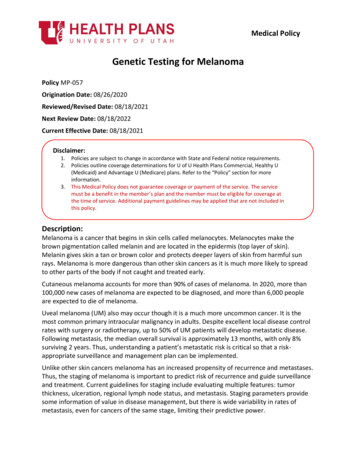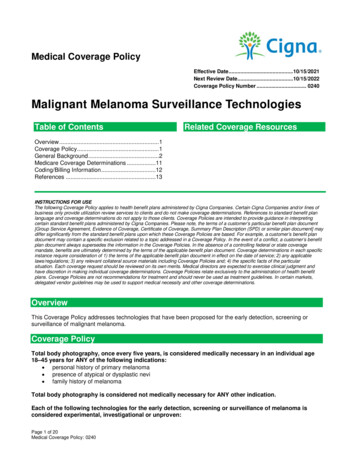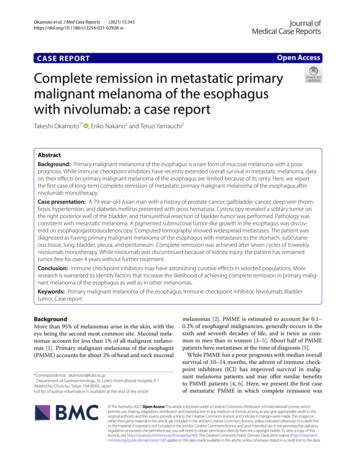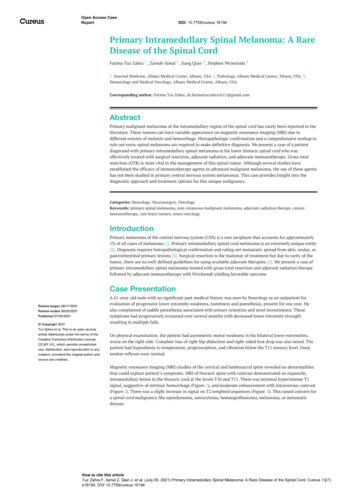
Transcription
Medical PolicyGenetic Testing for MelanomaPolicy MP-057Origination Date: 08/26/2020Reviewed/Revised Date: 08/18/2021Next Review Date: 08/18/2022Current Effective Date: 08/18/2021Disclaimer:1.2.3.Policies are subject to change in accordance with State and Federal notice requirements.Policies outline coverage determinations for U of U Health Plans Commercial, Healthy U(Medicaid) and Advantage U (Medicare) plans. Refer to the “Policy” section for moreinformation.This Medical Policy does not guarantee coverage or payment of the service. The servicemust be a benefit in the member’s plan and the member must be eligible for coverage atthe time of service. Additional payment guidelines may be applied that are not included inthis policy.Description:Melanoma is a cancer that begins in skin cells called melanocytes. Melanocytes make thebrown pigmentation called melanin and are located in the epidermis (top layer of skin).Melanin gives skin a tan or brown color and protects deeper layers of skin from harmful sunrays. Melanoma is more dangerous than other skin cancers as it is much more likely to spreadto other parts of the body if not caught and treated early.Cutaneous melanoma accounts for more than 90% of cases of melanoma. In 2020, more than100,000 new cases of melanoma are expected to be diagnosed, and more than 6,000 peopleare expected to die of melanoma.Uveal melanoma (UM) also may occur though it is a much more uncommon cancer. It is themost common primary intraocular malignancy in adults. Despite excellent local disease controlrates with surgery or radiotherapy, up to 50% of UM patients will develop metastatic disease.Following metastasis, the median overall survival is approximately 13 months, with only 8%surviving 2 years. Thus, understanding a patient’s metastatic risk is critical so that a riskappropriate surveillance and management plan can be implemented.Unlike other skin cancers melanoma has an increased propensity of recurrence and metastases.Thus, the staging of melanoma is important to predict risk of recurrence and guide surveillanceand treatment. Current guidelines for staging include evaluating multiple features: tumorthickness, ulceration, regional lymph node status, and metastasis. Staging parameters providesome information of value in disease management, but there is wide variability in rates ofmetastasis, even for cancers of the same stage, limiting their predictive power.
DecisionDx-Melanoma is a genetic test developed to assist in assessing the risk for recurrenceor metastasis of cutaneous based on the presence of specific gene expression. It usesquantitative reverse-transcription PCR (qRT-PCR) to measure the expression of 31 gene regionsto predict risk of metastasis and guide treatment decisions in patients with stage I or II primarycutaneous melanoma.The DecisionDx-UM test is for patients diagnosed with primary UM, without evidence ofmetastatic disease, and uses a 15-gene expression profile to identify the likelihood ofmetastasis within 5 years in patients with UM.Policy Statement and Criteria1. Commercial PlansU of U Health Plans does NOT cover genetic testing for the management of cutaneousmalignant melanoma including but not limited to DecisionDx-Melanoma, as it isconsidered investigational.U of U Health Plans does NOT cover genetic testing for the management of uvealmalignant melanoma or associated with susceptibility, including but not limited toDecisionDx-UM, as it is considered investigational.2. Medicaid PlansCoverage is determined by the State of Utah Medicaid program; if Utah State Medicaidhas no published coverage position and InterQual criteria are not available, the U of UHealth Plans Commercial criteria will apply. For the most up-to-date Medicaid policiesand coverage, please visit their website ry.php or the Utah Medicaid codeLook-Up toolCPT/HCPCS codes covered by Utah State Medicaid may still require further evaluationto determine medical necessity for coverage.3. Medicare PlansCoverage is determined by the Centers for Medicare and Medicaid Services (CMS); if acoverage determination has not been adopted by CMS and InterQual criteria are notavailable, the U of U Health Plans Commercial criteria will apply. For the most up-todate Medicare policies and coverage, please visit their search website verview-and-quicksearch.aspx?from2 search1.asp& or the manual website
Clinical RationaleCutaneous MelanomaIn 2019, Swetter et al published the updated American Academy of Dermatology (AAD) guidelines forthe care and management of primary cutaneous melanoma. Referral for genetic counseling and possiblegermline genetic testing for select patients with cutaneous melanoma was recommended forconsideration with a level IIIC grade of evidence. Although, surgery remains the cornerstone ofcutaneous melanoma treatment. The Work Group explained that "there is no strong evidence thatgenetic evaluation is either harmful or helpful."The National Comprehensive Cancer Network (NCCN) guidelines on Cutaneous Melanoma (Version3.2020) states: “Gene expression profiling (GEP) tests are marketed as being able to classify cutaneousmelanoma into separate categories based on risk of metastasis. However, it remains unclear whetherthese tests provide clinically actionable prognostic information when used in addition to or incomparison with known clinicopathologic factors or multivariable nomograms. Furthermore, the impactof these tests on treatment outcomes or follow-up schedules has not been established. Various (mostlyretrospective) studies of prognostic GEP testing suggest its role as an independent predictor of worseoutcome, though not superior to Breslow thickness or SLN status. The panel does not recommend BRAFor NGS testing for resected stage I–II cutaneous melanoma unless it will inform clinical trialparticipation. BRAF mutation testing is recommended for patients with stage III at high risk forrecurrence for whom future BRAF-directed therapy may be an option. For initial presentation with stageIV disease or clinical recurrence, obtain tissue to ascertain alterations in BRAF, and in the appropriateclinical setting, KIT from either biopsy of the metastasis (preferred) or archival material if the patient isbeing considered for targeted therapy.” In conclusion, to further define the clinical utility of moleculartesting prior to widespread implementation of GEP for prognostication of cutaneous melanoma, and inparticular to determine its role in guiding surveillance imaging, SLNB, and adjuvant treatment decisions,additional prospective validation studies are needed.Also in 2016, a retrospective analysis (Berger et al.) looked at the clinical management changes of 156patients with cutaneous melanoma, between May 2013 and December 2015, based on the outcome ofthe 31-gene expression DecisionDx-Melanoma test. Forty-two percent of patients were Stage I, 47%were Stage II and 8% were Stage III. Overall, 95 patients (61%) were Class 1 and 61 (39%) were Class 2.Documented changes in management were observed in 82 (53%) patients, with the majority of Class 2patients (77%) undergoing management changes compared to 37% of Class 1 patients (p 0.0001 byFisher's exact test). The majority (77/82, 94%) of these changes were concordant with the risk indicatedby the test result (p 0.0001 by Fisher's exact test), with increased management intensity for Class 2patients and reduced management intensity for Class 1 patients. In conclusion, the study was foundlimited for the assessment of the impact of gene expression profile based management changes onhealthcare resource utilization and patient outcome, as follow-up data was not collected for this patientcohort.A 2017 study (Ardakani et al) evaluated the ability of comparative genomic hybridization (CGH) todifferentiate between melanocytic naevi and melanoma in cases where the two show overlappinghistological features. Melanomas are characterized by CNVs, while naevi are normal. The team used 19formalin fixed, paraffin embedded (FFPE) unambiguous naevi and 19 melanomas, and tested them usinga SurePrint G3 Human CGH 8x60K array. CGH was able to differentiate between the naevi and themelanoma in 95% of cases. One nevus showed two large CNV. In conclusion, CGH may be a goodadjunctive test to resolve histologically equivocal melanocytic samples, still further studies are neededto demonstrate efficacy.
In 2017, Ferris et al. examined the clinical utility of DermTech’s noninvasive adhesive skin patch test PLA(pigmented lesion assay), which measures 2 gene expressions LINC00518 and PRAME for cutaneousmelanoma. The study compared the findings of 45 dermatologists who evaluated clinical anddermoscopic images of the lesions tested by PLA and based on their observations, recommended biopsyor not. All samples were biopsied, and readers were blinded to the histopathology. Sixty samples wereincluded that were obtained from March 2014 to November 2015, and determined 8 were melanomasand 52 were non-melanomas. The biopsy concordance using only the dermatologist review was 95%.When the PLA results were included, the biopsy concordance improved to 98.6%. Limitations of the testinclude not working on the palms of hands, soles of feet, mucous membranes, or nails. In conclusion,even though the data obtained in this study supports the clinical utility of the PLA test, clinical care willlikely be primarily influenced by the nature and location of the pigmented lesion and the need to obtainlesion information beyond clinical or dermatopathology-based image and pattern recognition.Therefore, further studies are needed to obtain relevant data and long-term future objectives beyondthe scope of this study.Then in 2018 Ferris et al. researched further clinical utility, this time in a real world analysis with anobservational cohort of 381 patients. The PLA test was positive in 51 patients, and all had a biopsy thatresulted in 37% diagnosed with melanoma. In the 330 negative PLA group, nearly all were managed bymonitoring. Three had biopsies, and none were found to be melanoma. The authors concluded, 93% ofPLA results positive for both LINC00518 and PRAME were diagnosed histopathologically as melanoma.PRAME-only and LINC00518-only lesions were melanomas histopathologically in 50 and 7%,respectively. However, the likelihood of positive histopathologic diagnosis of melanoma appears to behigher in PLA results that are positive for both genes.A 2018 multi-center trial (Zager et al) organized archived primary melanoma tumors from 523 patients,using a 31 gene expression classifier to classify patients as Class 1 (low risk) and Class 2 (high risk). The 5year recurrence free survival (RFS) rates for Class 1 and Class 2 were 88% and 52%, respectively. Distantmetastasis-free survival rates (DMFS) were 93% for Class 1 versus 60% for Class 2. The gene expressionclassifier was a significant predictor of RFS and DMFS in univariate analysis in addition to with Breslowthickness, ulceration, mitotic rate, and sentinel lymph node (SLN) status. GEP, tumor thickness and SLNstatus were significant predictors of RFS and DMFS in a multivariate model that also included ulcerationand mitotic rate. In conclusion, even though the GEP test provided value to prognostication, moreprospective studies are needed to look at its role for adjuvant therapy in patients.A 2019 UpToDate review discusses DecisionDX-Melanoma, the commercial gene expression profile testthat has been developed for patients with local (stage I and II) or loco-regional (stage III) cutaneousmelanoma. However, there is no definitive data regarding its use for risk classification in patients withcutaneous melanoma, nor does this test currently have a role in determining which patients arecandidates for adjuvant immunotherapy either as a standard of care or as part of clinical trials.Hayes Inc., also performed a Molecular Test Assessment on DecisionDx-Melanoma in 2020. Studieswhich qualified for inclusion in this review included 1 analytical validity study, 5 clinical validity studiesand 2 clinical utility studies – 8 studies in all. The analytical validity study of the DecisionDx-Melanomatest demonstrated the assay’s reproducibility and technical reliability producing consistent results.However, the review concluded that additional studies are needed for test accuracy measurements. The5 clinical validity studies provided preliminary evidence that the DecisionDx-Melanoma test predictsmetastasis in individuals with stage I or II primary cutaneous melanoma, mainly by comparing survivalendpoints between patients designated as class 1 and class 2 by the test. However, most studiesincluded patients not in the intended test population as defined by the laboratory and did not comparegene expression profile results with collective staging features as used in clinical practice. The 2 clinical
utility studies observed an impact on management decisions of treating physicians ordering the test.However, the authors found that it is not clear whether DecisionDx-Melanoma adds enough prognosticinformation to current clinicopathological staging factors to change patient management decisions andultimately improve outcomes. Also of note is that some or all authors in all studies had financial and/orother relationships with the testing laboratory and all studies were funded by the testing laboratory. Inconclusion, the overall quality of the evidence is very low and the studies did not evaluate whether thetest provided accurate, clinical actionable information resulting in improved patient outcomes. Morerobust studies are needed, that are not sponsored by the lab, to demonstrate a benefit in patientoutcomes with the DecisionDx-Melanoma test.A Systematic Review and Meta-analysis by Marchetti et al of the Current Performance of GeneExpression Profile Tests for Prognosis in Patients with Localized Cutaneous Melanoma was published inJAMA Dermatology in 2020. The authors conclude that "Gene Expression Profile Tests includingDecisionDX should still be considered investigational and not reliable as a standard of care inmanagement of melanoma." They summarize that "The prognostic ability of GEP tests among patientswith localized melanoma varied by AJCC stage and appeared to be poor at correctly identifyingrecurrence in patients with stage I disease, suggesting limited potential for clinical utility in thesepatients".Furthermore, a consensus statement by Grossman et al published in JAMA Dermatology in 2020concluded that "More evidence is needed to support using GEP testing to inform recommendationsregarding SLNB, intensity of follow-up or imaging surveillance, and postoperative adjuvant therapy. TheMPWG (Melanoma Prevention Working Group) recommends further research to assess the validity andclinical applicability of existing and emerging GEP tests".Uveal MelanomaHayes completed a Molecular Test Assessment in June 2020. Only 3 studies met inclusion criteria forreview. As it relates to analytic validity, the results of 1 study suggest that there is an established assayprocess that has been optimized and is reproducible for the DecisionDx-UM test. The assayreproducibility was supported by satisfactory concordance in the class calls. One study was identifiedthat assessed the analytical performance of the current DecisionDx-UM assay that includes 3 riskclasses. Plasseraud et al. (2017) assessed the analytical performance of the DecisionDx-UM assay, mainlyassay reproducibility comparing the concordance in risk class call (class 1A, 1B, and 2), using fresh frozenfine-needle aspiration biopsy samples and formalin-fixed paraffin-embedded tissue samples. Thelimitations of the overall evidence to support analytical validity include that other parameters, such assensitivity (limit of detection), linearity (range of assay concentration that fits within a linear scale), oramplification efficiency (accuracy of amplification) were not reported in the peer-reviewed literature.The impact of intratumor heterogeneity was also not addressed. The biggest strength of the evidence isthe laboratory reporting an approximate 5-year technical success rate of 96%. Taken together, there is avery low quality body of evidence supporting the analytical validity of the DecisionDx-UM test.Related to clinical utility, one study was identified that assessed the clinical utility of the DecisionDx-UMtest (Plasseraud et al., 2016). This study reported results from an interim analysis of the ongoing,prospective, multicenter Clinical Application of DecisionDx-UM Gene Expression Assay Results (CLEAR)registry. Although an association between clinical management decisions and DecisionDx-UM riskclasses were reported, the role of DecisionDx-UM in physician decisions was not clear. The articleincluded many limitations, and the CLEAR trial study start date was in 2010; thus, it was not clearwhether the DecisionDx-UM results used by the physicians included the 2- or 3-risk classification(ClinicalTrials.gov, 2018).
Overall, the quality of the evidence, was judged to be of very low quality to identify the likelihood ofmetastasis within 5 years in patients with UM. Only 3 studies were identified that provided data for theDecisionDx-UM test that included the 3 risk classes. Although an established assay process is in place,the validity of the test and the impact on patient management is unclear; additional data are needed tosupport the use of this test.Applicable CodingCPT Codes0089UOncology (melanoma), gene expression profiling by RTqPCR, PRAME andLINC00518, superficial collection using adhesive patch (es)0090UOncology (cutaneous melanoma), mRNA gene expression profiling by RT-PCR of23 genes (14 content and 9 housekeeping), utilizing formalin-fixed paraffinembedded tissue, algorithm reported as a categorical result (i.e., benign,indeterminate, malignant)81404Molecular Pathology Procedure Level 581445Targeted genomic sequence analysis panel, solid organ neoplasm, DNA analysis,and RNA analysis when performed, 5-50 genes (e.g., ALK, BRAF, CDKN2A, EGFR,ERBB2, KIT, KRAS, NRAS, MET, PDGFRA, PDGFRB, PGR, PIK3CA, PTEN, RET),interrogation for sequence variants and copy number variants orrearrangements, if performed81455Targeted genomic sequence analysis panel, solid organ or hematolymphoidneoplasm, DNA analysis, and RNA analysis when performed, 51 or greater genes(eg, ALK, BRAF, CDKN2A, CEBPA, DNMT3A, EGFR, ERBB2, EZH2, FLT3, IDH1, IDH2,JAK2, KIT, KRAS, MLL, NPM1, NRAS, MET, NOTCH1, PDGFRA, PDGFRB, PGR,PIK3CA, PTEN, RET), interrogation for sequence variants and copy numbervariants or rearrangements, if performed81479Unlisted molecular pathology procedure81599Unlisted multianalyte assay with algorithmic analysis84999Unlisted chemistry procedureHCPCS CodesNo applicable codesReferences:1.2.3.4.American Cancer Society (2020) “About Melanoma Skin Cancer” Last reviewed August 14, 2020. Accessed July 31, 2020.Available at: www.cancer.orgArdakani MN, Thomas C, Robinson C, et al. Detection of copy number variations in melanocytic lesions utilizing array basedcomparative genomic hybridization. Pathology. 2017 Apr;49(3):285-291.Berger AC, Davidson RS, Poitras JK, et al. Clinical impact of a 31-gene expression profile test for cutaneous melanoma in 156prospectively and consecutively tested patients. Curr Med Res Opin. 2016 Sep;32(9):1599-604.Bichakjian CK, Halpern AC, Johnson TM, et al. Guidelines of care for the management of primary cutaneous melanoma. J AmAcad Dermatol. 2011; 65:1032-1047.
3.24.25.26.27.Castle Biosciences, Inc (2020) “DecisionDx -Melanoma Overview” Accessed August 3, 2020. Available dx-melanoma/Chang AE, Karnell LH, Menck HR. The National Cancer Data Base report on cutaneous and noncutaneous melanoma: asummary of 84,836 cases from the past decade. The American College of Surgeons Commission on Cancer and the AmericanCancer Society. Cancer. Oct 15, 1998; 83(8): 1664-78. PMID 9781962ClinicalTrials.gov. 5 Year Registry Study to Track Clinical Application of DecisionDx-UM Assay Results and Associated PatientOutcomes (CLEAR). Updated January 25, 2018. Accessed August 12, 2020. Available 376920Ferris LK, Gerami P, Skelsey MK,et al. Real-world performance and utility of a noninvasive gene expression assay to evaluatemelanoma risk in pigmented lesions. Melanoma Res. 2018 Oct;28(5):478-482.Ferris LK, Jansen B, Ho J, et al. Utility of a noninvasive 2-gene molecular assay for cutaneous melanoma and effect on thedecision to biopsy. JAMA Dermatol. 2017;153(7):675–680.Gerami P, Alsobrook JP II, Palmer TJ, Robin HS. Development of a novel noninvasvie adhesive patch test for the evaluation ofpigmented lesions of the skin. J Am Acad Dermatol. 2014; 71:237-244.Gerami P, Yao Z, Polsky D, et al. Development and validation of a noninvasive 2-gene molecular assay for cutaneousmelanoma. J Am Acad Dermatol. 2017; 76(1):114-120.Gershenwald JE, Scolyer RA, Hess KR, et al. Melanoma staging: evidence-based changes in the American Joint Committee onCancer eighth edition cancer staging manual. CA Cancer J Clin. 2017;67(6):472-492.Grossman D, Okwundu N, Bartlett EK, Marchetti MA, Othus M, Coit DG, Hartman RI, Leachman SA, Berry EG, Korde L, Lee SJ.Prognostic gene expression profiling in cutaneous melanoma: identifying the knowledge gaps and assessing the clinicalbenefit. JAMA dermatology. 2020 Sep 1;156(9):1004-11.Hayes, Inc (2020) “DecisionDx-Melanoma”. Last review April 24, 2020. Accessed August 8, 2020. Available on3123Hayes, Inc (2020) “DecisionDx-UM” Last reviewed June 17, 2020. Accessed August 12, 2020. Available on2107Krantz BA, Dave N, Komatsubara KM, Marr BP, Carvajal RD. Uveal melanoma: epidemiology, etiology, and treatment ofprimary disease. Clin Ophthalmol. 2017;11:279-289.Marchetti MA, Coit DG, Dusza SW, Yu A, McLean L, Hu Y, Nanda JK, Matsoukas K, Mancebo SE, Bartlett EK. Performance ofgene expression profile tests for prognosis in patients with localized cutaneous melanoma: a systematic review and metaanalysis. JAMA dermatology. 2020 Sep 1;156(9):953-62.National Cancer Institute (NCI). Intraocular (uveal) melanoma treatment (PDQ ). Updated December 17, 2019. Available -melanoma-treatment-pdq. Accessed August 8, 2020.National Comprehensive Cancer Network (NCCN). Clinical Practice Guidelines in Oncology. Melanoma.v.2. 2019.National Comprehensive Cancer Network (NCCN). Clinical Practice Guidelines in Oncology . Cutaneous Melanoma v.3.2020.Accessed: August 8, 2020. Available at: https://www.nccn.org/professionals/physician gls/pdf/cutaneous melanoma.pdfNational Comprehensive Cancer Network (NCCN). NCCN clinical guidelines in oncology: uveal melanoma v.2.2020. May 21,2020. Available at: https://www.nccn.org/professionals/physician gls/pdf/uveal.pdf. Accessed August 8, 2020.Plasseraud KM, Cook RW, Tsai T, et al. Clinical performance and management outcomes with the DecisionDx-UM geneexpression profile test in a prospective multicenter study. J Oncol. 2016;2016::5325762. Epub June 30, 2016. AccessedAugust 12, 2020. Available at: https://doi.org/10.1155/2016/5325762Plasseraud KM, Wilkinson JK, Oelschlager KM, et al. Gene expression profiling in uveal melanoma: technical reliability andcorrelation of molecular class with pathologic characteristics. Diagn Pathol. 2017;12(1):59.Siegel RL, Miller KD, Jemal A. Cancer statistics, 2018. CA Cancer J Clin. Jan 2018; 68(1): 7-30. PMID 29313949Swetter, SM, Tsao, H, Bichakjian, CK, et al. Guidelines of care for the management of primary cutaneous melanoma. J AmAcad Dermatol. 2019 Jan;80(1):208-50. PMID: 30392755UpToDate (2019). “Tumor, node, metastasis (TNM) staging system and other prognostic factors in cutaneous melanoma”.Last reviewed May 8, 2019. Accessed August 5, 2020. Available at: www.uptodate.comZager JS, Gastman BR, Leachman S, et al. Performance of a prognostic 31-gene expression profile in an independent cohortof 523 cutaneous melanoma patients. BMC Cancer. 2018;18:130.Disclaimer:This document is for informational purposes only and should not be relied on in the diagnosis and care of individual patients.Medical and Coding/Reimbursement policies do not constitute medical advice, plan preauthorization, certification, anexplanation of benefits, or a contract. Members should consult with appropriate health care providers to obtain needed medicaladvice, care, and treatment. Benefits and eligibility are determined before medical guidelines and payment guidelines areapplied. Benefits are determined by the member’s individual benefit plan that is in effect at the time services are rendered.
The codes for treatments and procedures applicable to this policy are included for informational purposes. Inclusion or exclusionof a procedure, diagnosis or device code(s) does not constitute or imply member coverage or provider reimbursement policy.Please refer to the member's contract benefits in effect at the time of service to determine coverage or non-coverage of theseservices as it applies to an individual member.U of U Health Plans makes no representations and accepts no liability with respect to the content of any external informationcited or relied upon in this policy. U of U Health Plans updates its Coverage Policies regularly, and reserves the right to amendthese policies and give notice in accordance with State and Federal requirements.No part of this publication may be reproduced, stored in a retrieval system or transmitted, in any form or by any means,electronic, mechanical, photocopying, or otherwise, without permission from U of U Health Plans.”University of Utah Health Plans” and its accompanying logo, and its accompanying marks are protected and registeredtrademarks of the provider of this Service and or University of Utah Health. Also, the content of this Service is proprietary and isprotected by copyright. You may access the copyrighted content of this Service only for purposes set forth in these Conditions ofUse. CPT Only – American Medical Association
even though the data obtained in this study supports the clinical utility of the PLA test, clinical care will likely be primarily influenced by the nature and location of the pigmented lesion and the need to obtain lesion information beyond clinical or dermatopathology-based image and pattern recognition.











